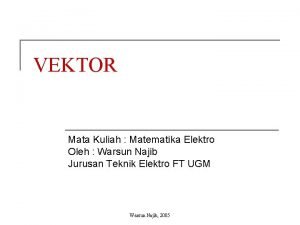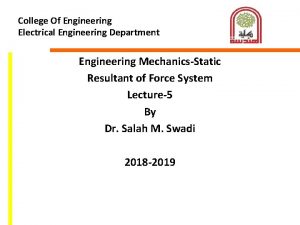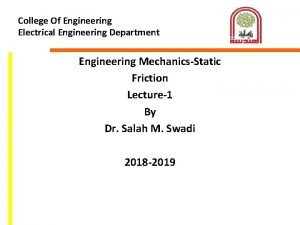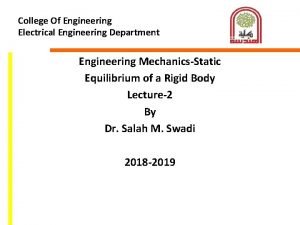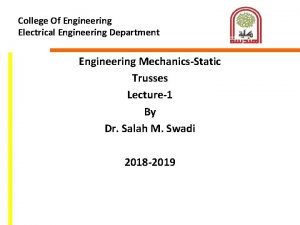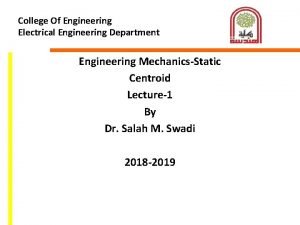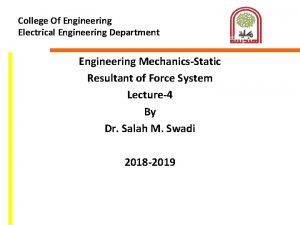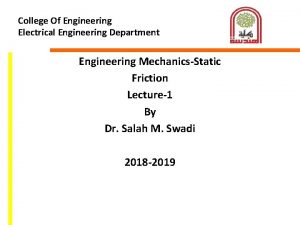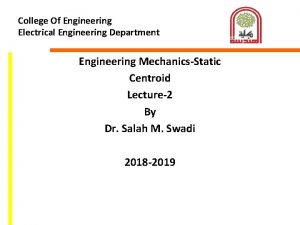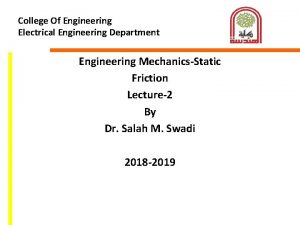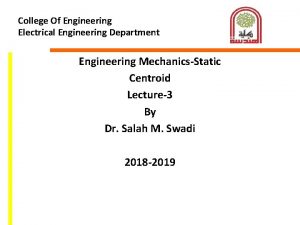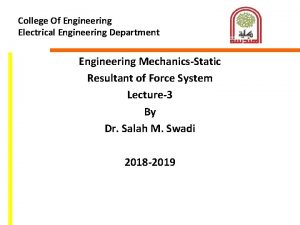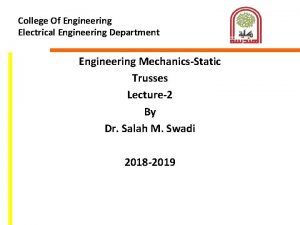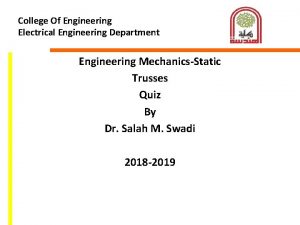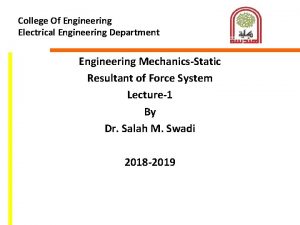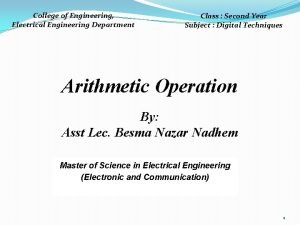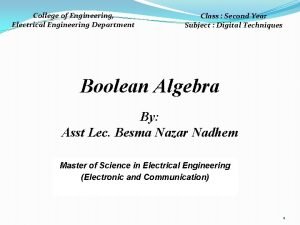College Of Engineering Electrical Engineering Department Engineering MechanicsStatic





















- Slides: 21

College Of Engineering Electrical Engineering Department Engineering Mechanics-Static Equilibrium of a Rigid Body Lecture-1 By Dr. Salah M. Swadi 2018 -2019

Chapter Objectives • Develop the equations of equilibrium for a rigid body • Concept of the free-body diagram for a rigid body • Solve rigid-body equilibrium problems using the equations of equilibrium

Chapter Outline 1. 2. 3. 4. 5. 6. 7. Conditions for Rigid Equilibrium Free-Body Diagrams Equations of Equilibrium Two and Three-Force Members Free Body Diagrams Equations of Equilibrium Constraints and Statical Determinacy

5. 1 Conditions for Rigid-Body Equilibrium • The equilibrium of a body is expressed as • Consider summing moments about some other point, such as point A, we require

5. 2 Free Body Diagrams Support Reactions • • If a support prevents the translation of a body in a given direction, then a force is developed on the body in that direction. If rotation is prevented, a couple moment is exerted on the body.

5. 2 Free Body Diagrams

5. 2 Free Body Diagrams

5. 2 Free Body Diagrams Internal Forces • • • External and internal forces can act on a rigid body For FBD, internal forces act between particles which are contained within the boundary of the FBD, are not represented Particles outside this boundary exert external forces on the system

5. 2 Free Body Diagrams Weight and Center of Gravity • • • Each particle has a specified weight System can be represented by a single resultant force, known as weight W of the body Location of the force application is known as the center of gravity

5. 2 Free Body Diagrams Procedure for Drawing a FBD 1. Draw Outlined Shape • Imagine body to be isolated or cut free from its constraints • Draw outline shape 2. Show All Forces and Couple Moments • Identify all external forces and couple moments that act on the body

5. 2 Free Body Diagrams 3. Identify Each Loading and Give Dimensions • Indicate dimensions for calculation of forces • Known forces and couple moments should be properly labeled with their magnitudes and directions

Example 5. 1 Draw the free-body diagram of the uniform beam. The beam has a mass of 100 kg.

Solution Free-Body Diagram

Solution Free-Body Diagram • Support at A is a fixed wall • Three forces acting on the beam at A denoted as Ax, Ay, Az, drawn in an arbitrary direction • Unknown magnitudes of these vectors • Assume sense of these vectors • For uniform beam, Weight, W = 100(9. 81) = 981 N acting through beam’s center of gravity, 3 m from A

5. 3 Equations of Equilibrium • For equilibrium of a rigid body in 2 D, ∑Fx = 0; ∑Fy = 0; ∑MO = 0 • ∑Fx and ∑Fy represent sums of x and y components of all the forces • ∑MO represents the sum of the couple moments and moments of the force components

5. 3 Equations of Equilibrium Alternative Sets of Equilibrium Equations • For coplanar equilibrium problems, ∑Fx = 0; ∑Fy = 0; ∑MO = 0 • 2 alternative sets of 3 independent equilibrium equations, ∑Fa = 0; ∑MA = 0; ∑MB = 0

5. 3 Equations of Equilibrium Procedure for Analysis Free-Body Diagram • Force or couple moment having an unknown magnitude but known line of action can be assumed • Indicate the dimensions of the body necessary for computing the moments of forces

5. 3 Equations of Equilibrium Procedure for Analysis Equations of Equilibrium • Apply ∑MO = 0 about a point O • Unknowns moments of are zero about O and a direct solution the third unknown can be obtained • Orient the x and y axes along the lines that will provide the simplest resolution of the forces into their x and y components • Negative result scalar is opposite to that was assumed on the FBD

Example 5. 5 Determine the horizontal and vertical components of reaction for the beam loaded. Neglect the weight of the beam in the calculations.

Solution Free Body Diagrams • 600 N represented by x and y components • 200 N force acts on the beam at B

Solution Equations of Equilibrium
 Electrical engineering department
Electrical engineering department Tum
Tum Ucla electrical engineering
Ucla electrical engineering Pasadena city college police department
Pasadena city college police department Pengurangan vektor
Pengurangan vektor Gwu electrical engineering
Gwu electrical engineering Tel aviv university electrical engineering
Tel aviv university electrical engineering Northwestern electrical engineering
Northwestern electrical engineering Klipsch school of electrical and computer engineering
Klipsch school of electrical and computer engineering Umd ece faculty
Umd ece faculty Types of estimation in electrical engineering
Types of estimation in electrical engineering Electrical engineering environmental issues
Electrical engineering environmental issues Cs flowchart wpi
Cs flowchart wpi Electrical engineering presentation
Electrical engineering presentation Kfupm ee faculty
Kfupm ee faculty Big data in electrical engineering
Big data in electrical engineering Define electrical engineering
Define electrical engineering Basic electrical engineering kulshreshtha
Basic electrical engineering kulshreshtha University of belgrade school of electrical engineering
University of belgrade school of electrical engineering Electrical engineering notation
Electrical engineering notation Ntou ee
Ntou ee Electrical engineering definition
Electrical engineering definition




